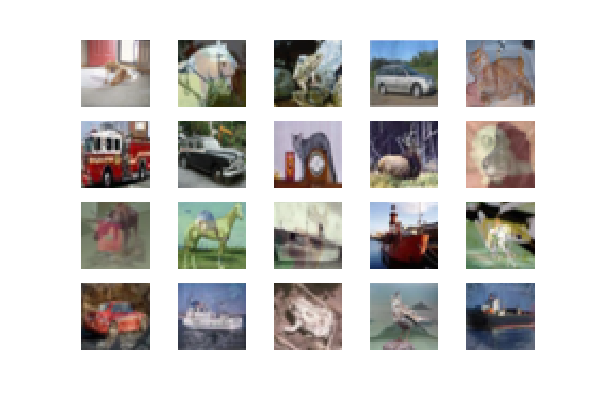はじめに
最近arXivに論文が公開されたdata augmentation手法であるmixupが非常にシンプルな手法だったので試してみました。
mixup
mixup1は、2つの訓練サンプルのペアを混合して新たな訓練サンプルを作成するdata augmentation手法の1つです。
具体的には、データとラベルのペア$(X_1, y_1)$, $(X_2, y_2)$から、下記の式により新たな訓練サンプル$(X, y)$を作成します。ここでラベル$y_1, y_2$はone-hot表現のベクトルになっているものとします。$X_1, X_2$は任意のベクトルやテンソルです。
X = \lambda X_1 + (1 - \lambda) X_2 \\
y = \lambda y_1 + (1 - \lambda) y_2
ここで$\lambda \in [0, 1]$は、ベータ分布$Be(\alpha, \alpha)$からのサンプリングにより取得し、$\alpha$はハイパーパラメータとなります。特徴的なのは、データ$X_1, X_2$だけではなく、ラベル$y_1, y_2$も混合してしまう点です。
この定式化の解釈の参考記事:
http://www.inference.vc/mixup-data-dependent-data-augmentation/
実装
ジェネレータとして実装します。
https://github.com/yu4u/mixup-generator
import numpy as np
class MixupGenerator():
def __init__(self, X_train, y_train, batch_size=32, alpha=0.2, shuffle=True, datagen=None):
self.X_train = X_train
self.y_train = y_train
self.batch_size = batch_size
self.alpha = alpha
self.shuffle = shuffle
self.sample_num = len(X_train)
self.datagen = datagen
def __call__(self):
while True:
indexes = self.__get_exploration_order()
itr_num = int(len(indexes) // (self.batch_size * 2))
for i in range(itr_num):
batch_ids = indexes[i * self.batch_size * 2:(i + 1) * self.batch_size * 2]
X, y = self.__data_generation(batch_ids)
yield X, y
def __get_exploration_order(self):
indexes = np.arange(self.sample_num)
if self.shuffle:
np.random.shuffle(indexes)
return indexes
def __data_generation(self, batch_ids):
_, h, w, c = self.X_train.shape
_, class_num = self.y_train.shape
X1 = self.X_train[batch_ids[:self.batch_size]]
X2 = self.X_train[batch_ids[self.batch_size:]]
y1 = self.y_train[batch_ids[:self.batch_size]]
y2 = self.y_train[batch_ids[self.batch_size:]]
l = np.random.beta(self.alpha, self.alpha, self.batch_size)
X_l = l.reshape(self.batch_size, 1, 1, 1)
y_l = l.reshape(self.batch_size, 1)
X = X1 * X_l + X2 * (1 - X_l)
y = y1 * y_l + y2 * (1 - y_l)
if self.datagen:
for i in range(self.batch_size):
X[i] = self.datagen.random_transform(X[i])
return X, y
training_generator = MixoutGenerator(x_train, y_train)()で、訓練データとラベルの集合を引数としてジェネレータを取得し、x, y = next(training_generator)で学習用のバッチが取得できます。
CIFAR-10データセットを利用してmixupした例です。

ぼんやり2枚の画像がアルファ合成されたような画像が出力されます。
ジェネレータを利用した訓練
例えばKerasであれば、ジェネレータをそのまま学習する関数に渡してあげれば学習することができます。
model.fit_generator(generator=training_generator,
steps_per_epoch=x_train.shape[0] // batch_size,
validation_data=(x_test, y_test),
epochs=epochs, verbose=1,
callbacks=callbacks)
Kerasには、画像をランダムにスケーリングしたり、シフトしたりしてくれる便利なImageDataGeneratorがあり、これと組み合わせることもできます。
datagen = ImageDataGenerator(
width_shift_range=0.1,
height_shift_range=0.1,
horizontal_flip=True)
training_generator = MixupGenerator(x_train, y_train, datagen=datagen)()
このケースでは、まずmixupされたデータが作成され、その後ImageDataGeneratorによりランダムな変換が加えられます。

実験結果
Kerasのサンプルのcifar10_resnet.pyを少しいじって実験してみました。
mixupを使わないケース:
Test loss: 0.862150103855
Test accuracy: 0.8978
mixupを使うケース($\alpha = 0.2$):
Test loss: 0.510702615929
Test accuracy: 0.9117
1回のみの試行ですが、効果はありそうです。個人的には、こちらの記事で紹介しているRandom Erasingのほうが画像ドメインでは効果がありそうな印象ですが、組み合わせてみるのも面白いかもしれません。学習させられてるネットワークからすると、ランダムに2枚の画像が合成されたり、ランダムに画像の一部が欠落させられたりして、たまったものではないですが…
-
H. Zhang, M. Cisse, Y. N. Dauphin, and D. Lopez-Paz, "mixup: Beyond Empirical Risk Minimization," in arXiv:1710.09412, 2017. ↩